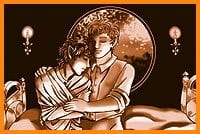“For whatever reason, what is good for the gander leaves the goose cold: few women report being aroused by the sight of men kissing each other.”
* Alessandra Stanley in a preview of Showtime’s new lesbocentric TV series The L Word, published in the New York Times on Jan 16
***
Think again, sister. Housewives waiting for their kids to come home from school, office workers on their lunch breaks, university students in between classes; women the world over are producing and consuming gay male smut.
Slash fiction – so-called because of the punctuation between character names indicating sexual interest as in Lord Of The Rings’ Legolas/Aragorn or Harry Potter’s Potter/Malfoy – is the teasing out of queer subtext found in pop culture and literature. It’s all over the Internet and is overwhelmingly the product of the female imagination.
Those in the know say that slash sprung up in the late 1960s, beginning with speculaton as to the secret lives of the brash starship captain James T Kirk and his über-logical science officer Spock from the original Star Trek series. At first, these stories were passed on through fanzines and privately circulated manuscripts. But, along with the rest of the fan fiction genre, slash came into its own with widespread Internet access.
Today there are thousands of websites devoted to slashing every possible combination of characters you can name. Slash may have started with TV shows, but it’s since spread to movies, books, commercials, sports and politics. From Todd Bertuzzi to the Verizon guy (“Can you hear me now?”) to George W Bush, everyone is fair game as far as slashers are concerned.
But what is the appeal? Why do so many women spend their time poring over fantasies that they aren’t a part of?
“So many people dislike answering that question,” says Calgary slasher Eden Lackner. “I mean, why not? Why should we have to be explaining it when you’ve got heterosexual males being terribly focussed on pseudo lesbian relationships?”
But 27-year-old Lackner, who recently completed a master’s degree in Victorian literature at the University Of Calgary, does have her theories. For starters, she points to a roster of less than inspiring female television characters for fans to work with. “It’s the girlfriend of the week syndrome,” she says. “The problem with these shows is that they present really shallow husks for women.
“Star Trek is the obvious one. Captain Kirk comes in and he has the love interest for the episode and she’s gone by the end. He’ll say or demonstrate that the mission or the crew or the greater is good is more important than she is and she’ll have to be sacrificed.
“Then you’ll have this male friend who is so important to him that not only does the relationship carry on throughout the whole series but he’s willing to put the mission at risk or the crew at risk just to save this one person.”
But she adds it would be an injustice to the male characters to leave it at that. “It’s a case of being drawn to the character and wanting to spend more time with them. Slash is a way to take a text or TV or the movies or a printed text and turn it on its head, view it in a different light and actively engage with it…. Instead of the way production companies would have us do these sorts of things: by planting your ass on the couch passively, buying their stuff and that’s it.”
Lackner, who is straight, started out as a devotee of Japanese anime, which has its own homo-fixated sects. She hypothesizes that there are as many motivations for slash as there are slashers. But of course, “there’s the old standby: because it’s hot. Because why focus on one man when you can have two or three?”
Fifteen-year-old Caitlyn Spencer, also of Calgary, agrees. “I think it’s just really our strange little fantasies put down on paper. I think that girls put their fantasies on paper and most guys seem to put it on videotape. You’ll probably know the answer to why it’s addictive. Two guys, wow!
“I think the reason I’ve always liked slash is because when I read about a guy I [have a] crush on doing stuff to another guy I don’t feel threatened, just turned on.”
Spencer, who identifies as bisexual, has been reading and writing slash since she was 14. She started out with Lord Of The Rings slash – which is so monstrously large that it is further broken down into elf-slash, hobbit-slash, man-slash and interspecies-slash – but has now moved on to Harry Potter. Both of these fandoms are considered gateway fandoms because of the high number of new and younger writers.
Spencer classifies her own slash writing as ranging from the PG-13 rating all the way up to NC-17. “A few months ago, back when I was writing Lord Of The Rings things, I let my mom read one,” says Spencer. “She said it was very well written and walked away muttering, ‘My daughter the 14-year-old pornographer.'”
Spencer doesn’t think much of censorship legislation that would make it illegal for her to write about characters her own age. “I think it’s stupid when people judge by age. I know there’s got to be five-year-olds out there that have done more than I have and I know I’ve been through more than half of the 30-year-olds I know…. It seems like most people around my age nowadays are doing far worse things than reading NC-17 things. Everyone else is doing NC-17 things.”
Lianne Burwell of Kingston also started writing fan fiction as a kid, but didn’t graduate to slash until much later. “Like everyone else, I wrote stories about my favourite shows; very Mary Sue-ish,” says Burwell, referring to the type of fan fiction where the writer superimposes her own character onto the plot.
Now 35, Burwell says her passion for slash was sparked after she stumbled across a story on-line involving a three-way between Star Trek Voyageur characters Tom Paris, B’Elanna Torres and Harry Kim. “At that point I was lost,” says Burwell. “I started looking for slash in every series I had ever watched.
“Part of it was the sex. I had discovered a kink I never knew I had. Part of it was that this was something that was never going to be shown on television or in licensed books. Part of it was that slash writers tend to be older, resulting in slightly better quality [than other fan fiction].”
That said, Burwell says it was the abundance of poorly written slash that encouraged her to try her own hand at it. “I blushed all the way through the sex scene, threw it out, rewrote it, had it beta-edited twice, then posted,” says Burwell. “And discovered the crack cocaine of fandom: feedback. After that there was no turning back.”
Burwell, who works in the software industry, describes her own sexuality as non-practising. “I find sex an incredibly interesting subject that at the moment I have no interest in going out and experiencing.”
Although she finds there is variation between fandoms, the women writing slash are predominately straight. “The one big exception being the Xena fandom,” Burwell notes. “It’s the fandom with the heaviest number of lesbians involved in writing and reading. It tends to be a little outside the standard fandom. They prefer not to use the term slash, they refer to it as ‘alternative fiction.’ I’ve run into some Xena fans who are adamant with not being identified with slash at all.”
Iris Gray, also 35, credits Xena and other shows with strong female characters with popularizing femmeslash. “I’ve noticed a recent explosion,” says Gray. “A lot of it is there are more shows that inspire it. It started out mainly with Xena and then there was Buffy… then people started saying, ‘Oh, there is such a thing as female/female slash,’ and started getting into it.”
A bisexual woman living in Victoria, Gray says part of her attraction to slash is the opportunity to imagine men the way she likes them. “It’s a chance to see men doing things that are normally limited to female characters in romance fiction – being vulnerable, being romantic and affectionate, being loving,” says Gray. “All the things that many straight women wish their male partners would be.”
Primarily a writer of male/male slash herself, Gray does make an effort to incorporate details of her own queer life into her writing, including references to Parents, Family And Friends Of Lesbians And Gays (PFLAG) and the Metropolitan Community Church (MCC). But she says that the majority of slash writers have a very limited understanding of queer realities.
“A lot of the writing is not really relevant to people’s day to day life of being gay,” says Gray. “They even go to the extent of saying [the characters are] not really gay, they’re just attracted to the person they happen to be involved with but not anybody else of the same sex.”
At the same time, she believes slashers are doing their part in furthering queer issues. “I find slash fans are generally the most tolerant people on the ‘net,” says Gray. “They’re the ones that are campaigning for same-sex marriage.”
All of the women interviewed agree that, when it comes down to it, slash means more to them than just a way to get off; it offers a sense of belonging.
“Once your slash-coloured glasses are issued it’s hard to turn them in and leave,” says Lackner. “You may enter the slash community for the simple reason that guy-on-guy action is hot, but I think it’s fair to say that you stay and continue to write in order to participate in the community.”

 Why you can trust Xtra
Why you can trust Xtra


